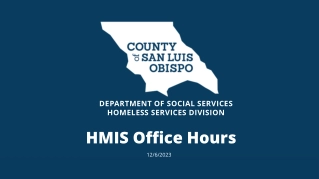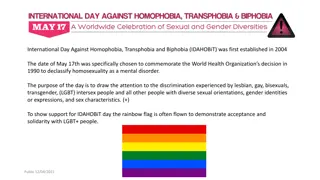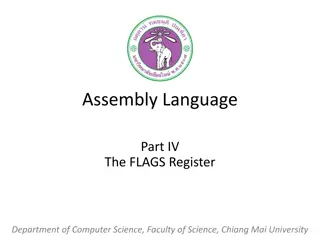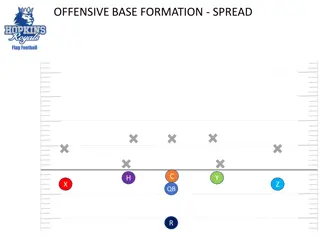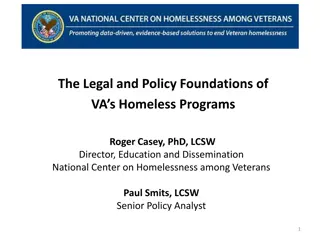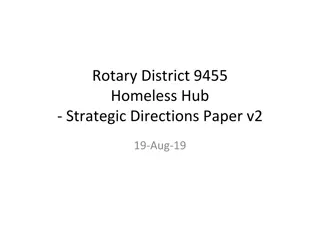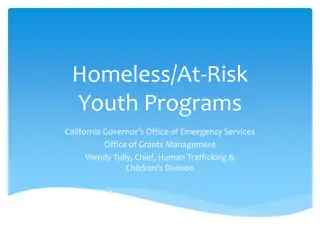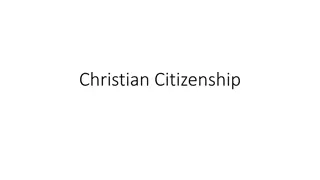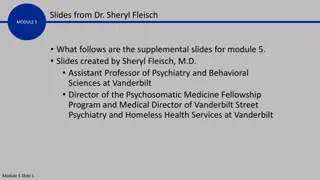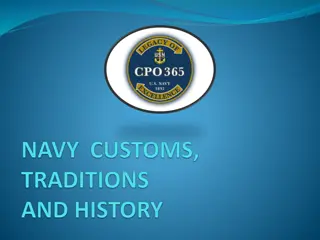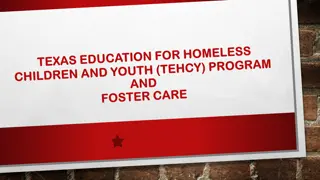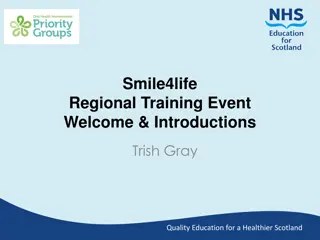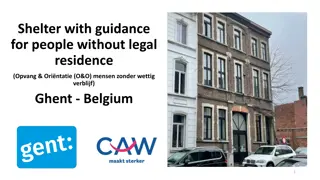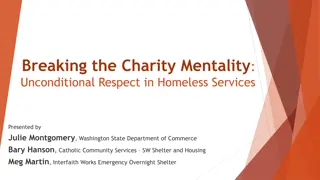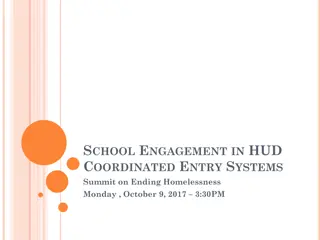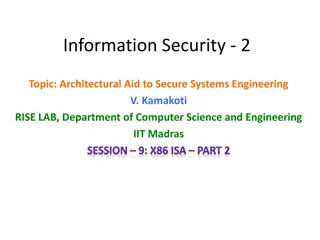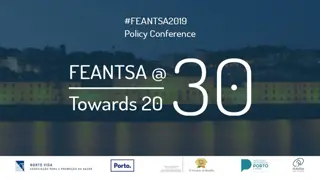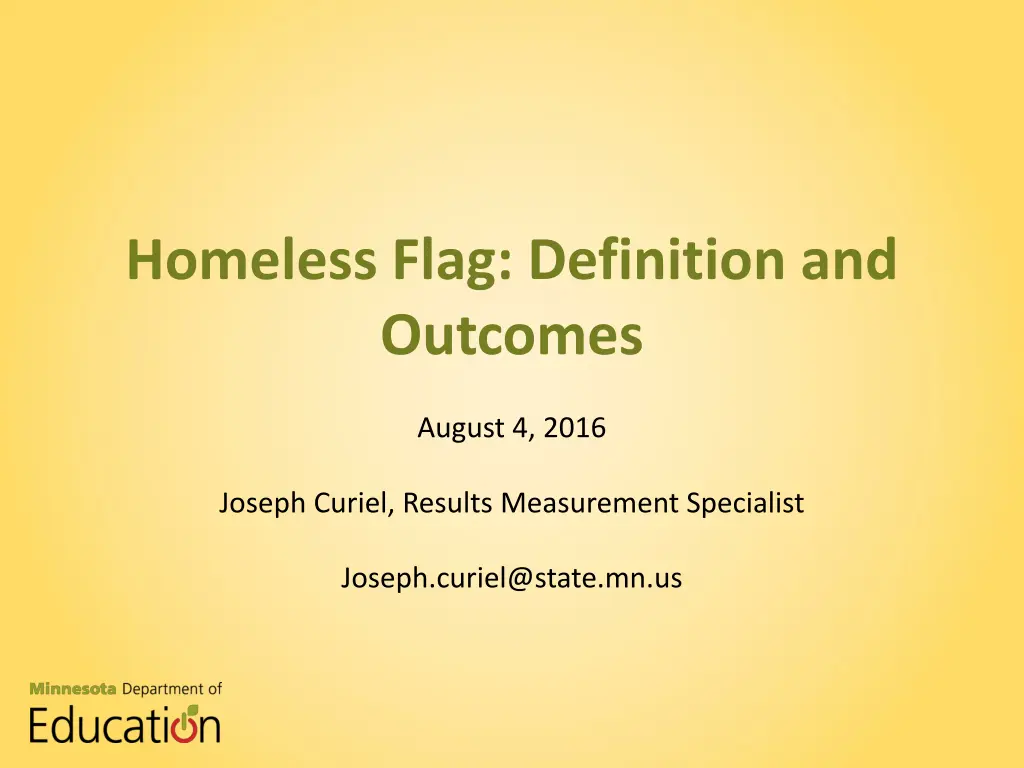
Understanding Homeless Identification Challenges and Support Systems
Explore the complexities of identifying homeless students under the McKinney-Vento Act, including the struggles families face in disclosing their situations and the importance of designated liaisons in supporting this vulnerable population. Learn about legal definitions, outcomes, and the impact of the McKinney-Vento Act on educational rights.
Download Presentation

Please find below an Image/Link to download the presentation.
The content on the website is provided AS IS for your information and personal use only. It may not be sold, licensed, or shared on other websites without obtaining consent from the author. If you encounter any issues during the download, it is possible that the publisher has removed the file from their server.
You are allowed to download the files provided on this website for personal or commercial use, subject to the condition that they are used lawfully. All files are the property of their respective owners.
The content on the website is provided AS IS for your information and personal use only. It may not be sold, licensed, or shared on other websites without obtaining consent from the author.
E N D
Presentation Transcript
Homeless Flag: Definition and Outcomes August 4, 2016 Joseph Curiel, Results Measurement Specialist Joseph.curiel@state.mn.us
The federal law The McKinney-Vento Act (1987): Ensures educational rights and protections for children and youth experiencing homelessness Dictates that every Local Educational Agency (LEA) must designate an appropriate staff person as a local homeless education liaison
The definition The McKinney-Vento Act (Section 725) Children and youth (including preschoolers) who lack a fixed, regular, and adequate nighttime residence Children and youth who are sharing the housing of other persons due to loss of housing Children and youth living in motels, hotels, trailer parks, cars, public spaces, abandoned buildings, substandard housing, bus or train stations, camping grounds Children and youth living in emergency or transitional shelters Children who have been abandoned in hospitals Migratory (or immigrant) children and youth who are living in a situation described above
Exercise Get creative: Think of a living situation(s) that may be unclear whether or not to flag the student as homeless given the legal definition Describe that situation(s) on your sticky note
Identification Students are flagged in MARSS Once identified, students retain the flag for the remainder of the school year Identification is up to the homeless liaison (and the LEA) Families may not know about the act Families may choose to take advantage of services but the LEA should still count students as homeless
Identification struggles Families may not disclose their situation Children can go unnoticed Students and parents try to hide their situation Families fear social agencies ability to take their children Older children may not report, because they fear being returned to an unsafe home Families who are sheltering other relatives (doubling up) may be very invisible and hard to locate
Requirements Identify homeless children and youth Ensure that children and youth experiencing homelessness enroll in, and have a full and fair opportunity to succeed in school Ensure that families, children and youth receive educational services for which they are eligible, including Head Start, Even Start and other public preschool programs, and referrals to health care, dental, mental health and other appropriate services
Requirements (continued) Inform parents and guardians of the educational and related opportunities available to their children and provide them with meaningful opportunities to participate in that education Disseminate public notice of educational rights Ensure that enrollment disputes are mediated Inform families and youth about transportation services and assist them in accessing transportation Must provide transportation to and from the school of origin if in the students best interest
Exercise Unique living situation: What living situations are unclear whether or not to flag the student as homeless given the legal definition?
Homeless flag statewide 2.0% 1.5% 2013 1.0% 2014 2015 1.4% 1.2% 1.1% 0.5% 0.0% Homeless Oct 1
Homeless student demographics Consider: As we describe homeless student demographics, ask yourself what else do I want to know about the homeless student population? Write your thoughts on a sticky note
Concentrations of homelessness by ethnicity 80% 70.4% 70% 60% 2015 Homeless 46.8% 50% 40% 27.9% 30% 2015 % of MN Student Population 20% 11.8% 11.5% 10.1% 8.4% 7.2% 10% 3.4% 2.4% 0% American Indian Asian or Pacific Islander Hispanic Black White
Concentrations of homelessness over time 60.0% 50.2% 50.0% 50.0% 46.8% 40.0% 27.9% 30.0% 27.0% 2013 24.2% 2014 20.0% 2015 12.5% 11.8% 11.2% 10.1% 9.3% 8.6% 10.0% 3.8% 3.4% 3.1% 0.0% American Indian Asian or Pacific Islander Hispanic Black White
Concentrations of homelessness by special populations 100% 90% 80% 2015 Homeless 70% 60% 50% 98.0% 40% 2015 % of not homeless students 30% 20% 38.2% 27.0% 10% 15.3% 10.0% 8.2% 0% English Learner Special Education Free or Reduced Lunch
Homelessness Grade Variation Grade Homeless % 1 1.6% 2 1.6% 3 1.5% 4 1.5% 5 1.3% 6 1.2% 7 1.2% 8 1.2% 9 1.1% 10 1.1% 11 1.0% 12 1.8% Statewide 1.4%
Persistence of homelessness 6.0% 20.7% One year Two years Three years 73.4%
Homeless student demographics Your thoughts: What else do I want to know about the homeless student population?
Homeless student outcomes Consider: As we describe homeless student outcomes, ask yourself what other outcomes might be influenced by homelessness? Write your thoughts on a sticky note
Homelessness and attendance by ethnicity 100% 90% 80% Non-homeless 70% Homeless 60% 50% Black 94.1% 85.4%92.2% 85.0%88.0%81.8% 40% Black homeless 30% American Indian 20% American Indian homeless 10% 0% 2015
Homelessness and attendance by grade level 100% 90% 80% 70% 60% All non-homeless 50% 95.3% 92.8% 90.2% Homeless 40% 79.4% 30% 20% 10% 0% Grades 1-6 Grades 7-12
Homelessness and math proficiency by ethnicity 100% 18.5% 90% 36.8% 80% 42.5% 50.6% 53.0% 20.5% 70% 63.6% 60% 26.2% 50% 24.4% 35.1% 40% 23.1% 23.2% 30% 20.5% 27.1% 24.6% 20% 20.0% 18.3% 25.9% 10% 12.7% 9.8% 8.5% 6.3% 5.5% 3.2% 0% Non-homeless Homeless Black Black homeless American Indian American Indian Homeless Exceeds Meets Partially meets Does not meet
Homelessness and reading proficiency by ethnicity 100% 90% 21.1% 37.1% 80% 43.5% 54.1% 54.5% 70% 18.8% 63.3% 60% 23.7% 50% 21.6% 40.1% 40% 18.8% 20.6% 30% 18.9% 31.2% 27.8% 20% 22.5% 20.6% 15.0% 10% 20.0% 8.1% 7.1% 4.7% 4.2% 2.9% 0% Non-homeless Homeless Black Black homeless American Indian American Indian Homeless Exceeds Meets Partially meets Does not meet
Homelessness and graduation rates by ethnicity 100% 4.4% 9.7% 13.6% 19.3% 90% 20.0% 20.9% 13.3% 80% 28.4% 27.8% 70% 35.7% 60% 42.0% 41.9% 50% 82.3% 40% 61.9% 30% 58.6% 44.2% 20% 38.7% 37.2% 10% 0% Non-homeless Homeless Black Black homeless American Indian American Indian Homeless Graduated Continuing Unknown Dropout
Homeless student outcomes Your thoughts: What other outcomes might be influenced by homelessness?
A study on stable housing Collaboration between MDE and Minnesota Housing Finance Agency Assess the impact of rent subsidy (stable housing) for homeless students on attendance, school mobility, test scores Quasi-experimental matched comparison study Results in 2017

